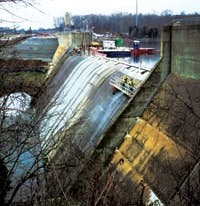The City of Manassas Public Works and Utilities in Manassas, Va., has had a good year. In June, it received the 2011 Excellence in Water Treatment Plant Performance Award from the Virginia Department of Health Office of Drinking Water for going above and beyond standard water treatment regulations.
Tony Dawood, deputy director of water and sewer for the city of Manassas, said he believes the honor was earned as a result of its recent plant upgrades—and for its dedicated staff.
“Plant personnel faced many challenges during the [upgrade] process [because] it’s a 40-year-old plant,” Dawood said. “The team was very pleased to receive the award and be recognized by the state and city officials. The state presented the award to the mayor, city council and plant personnel during a council meeting, which was very gratifying.”
Built for Growth
The Manassas water treatment plant (WTP) was conceived in the early 1960s. City officials determined that the well system in place at the time would not accommodate future growth, so they embarked on a plan to develop an alternative water supply using Lake Manassas and the city’s current WTP.
Fast forward to today, and the WTP services 38,000 customers. The current permitted capacity is 14 million gal per day (mgd). The plant’s two wholesale customers—Prince William County Service Authority and the city of Manassas Park—utilize 5 to 6 mgd and 0.5 to 1 mgd, respectively, and the two major industrial users in the area—Micron and Lockheed Martin—use 2 to 4 mgd
on average.
Plant infrastructure consists of piping, raw water pumps, rapid mix chambers, flocculation basins, filtration systems, sedimentation basins, a combined filter effluent chamber, a clear well, a sludge vacuum system and a backwash surge tank. The plant also is on the verge of being fully automated, Dawood said.
“What’s unique about our facility is the two different treatment processes used to produce potable water,” Dawood explained. “The plant includes a conventional water treatment process train with a capacity of 8 mgd, as well as a solids contact clarifier (superpulsator, also referred to as an upflow clarifier) with a green, lean filters process rated at 6 mgd.”
Changes & Challenges
Even with increased efficiency, the Manassas WTP experiences region-specific water treatment issues. According to Dawood, the Long-Term 2 Enhanced Surface Water Treatment Rule (LT2) and the Stage 2 Disinfectants and Disinfection Byproducts Rule (DBPR), administered by the U.S. Environmental Protection Agency (EPA), are affecting the plant’s operations. The LT2 instilled additional Cryptosporidium treatment requirements to higher-risk systems, and the Stage 2 DBPR tightened compliance monitoring requirements for trihalomethanes and haloacetic acids.
A new EPA pesticide regulation, Pesticide General Permit-VAG87, also precipitated change at the Manassas WTP. “Prior to the regulations, routine maintenance treatments to the lake to control algae [were] permitted,” Dawood said. “The promulgations of this new regulation require identifying and quantifying algae concentrations prior to treatment, thus causing the operations to be reactive rather than proactive.”
Besides the operational adjustments brought about by these regulations, recent plant upgrades have played a major role in enhancing efficiency as well. According to Dawood, the plant recently received new conduits, feed line, chemical storage improvements, new filter media, a new carbon silo and a revamped sludge removal system.
Dawood pointed to the new sludge removal system as a best practice he is particularly proud of. “In years past, we disposed of the sludge resulting from plant operations by means of pumping and hauling,” he said. “In 2009, we entered into an agreement with Prince William County Service Authority to utilize their sanitary sewer system to dispose of our sludge. This involved pump replacement and a major force main connecting to their sanitary sewer system.”
As for the future of the plant, Dawood said it will keep increasing capacity. The city plans to rerate the WTP in order to fully utilize the available Lake Manassas water supply and eventually reach an 18-mgd capacity.
Download: Here


